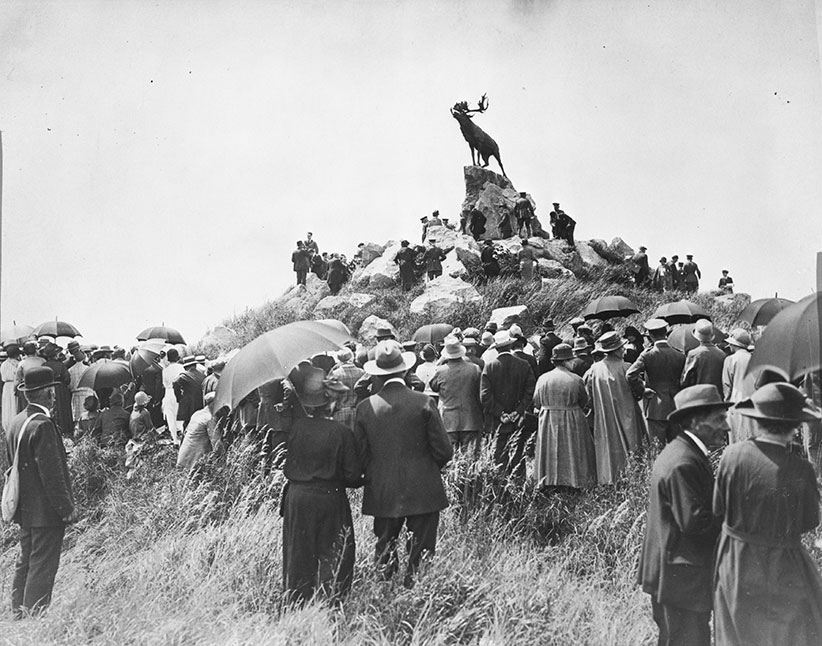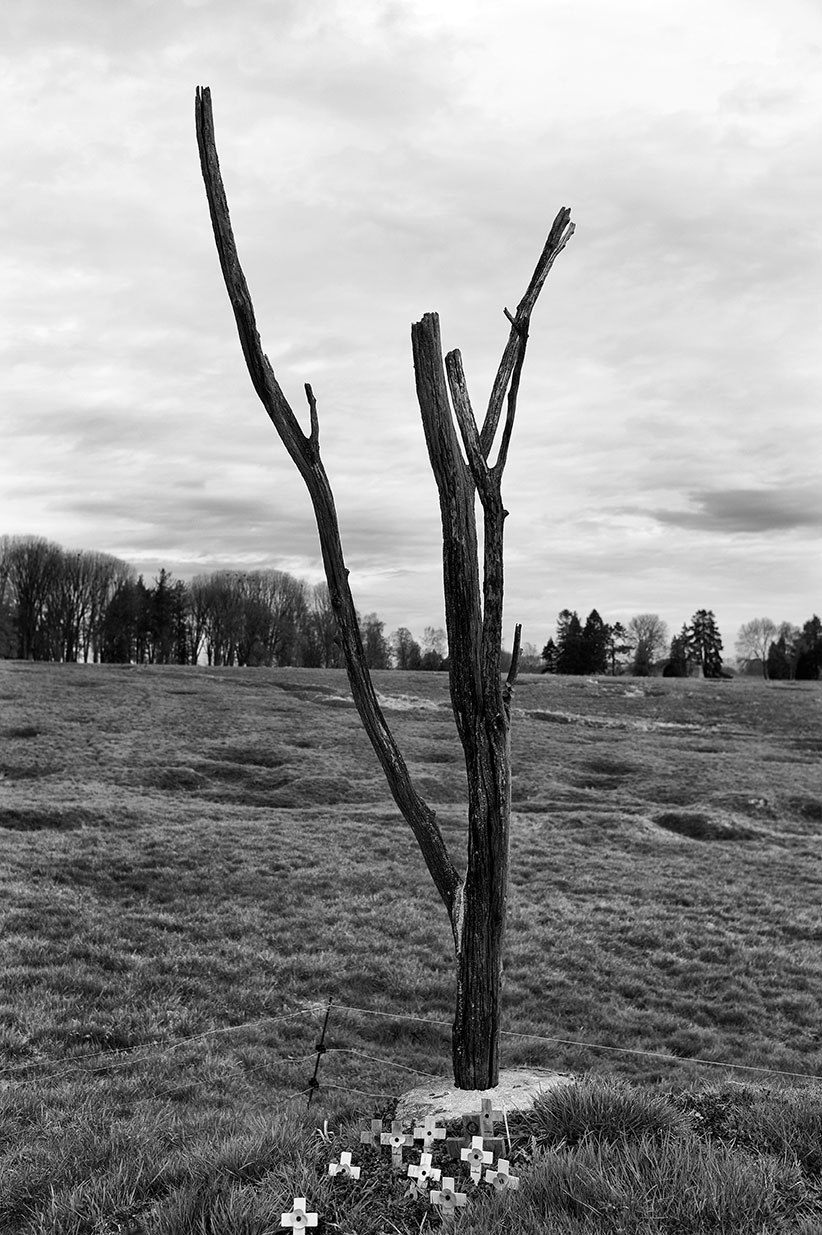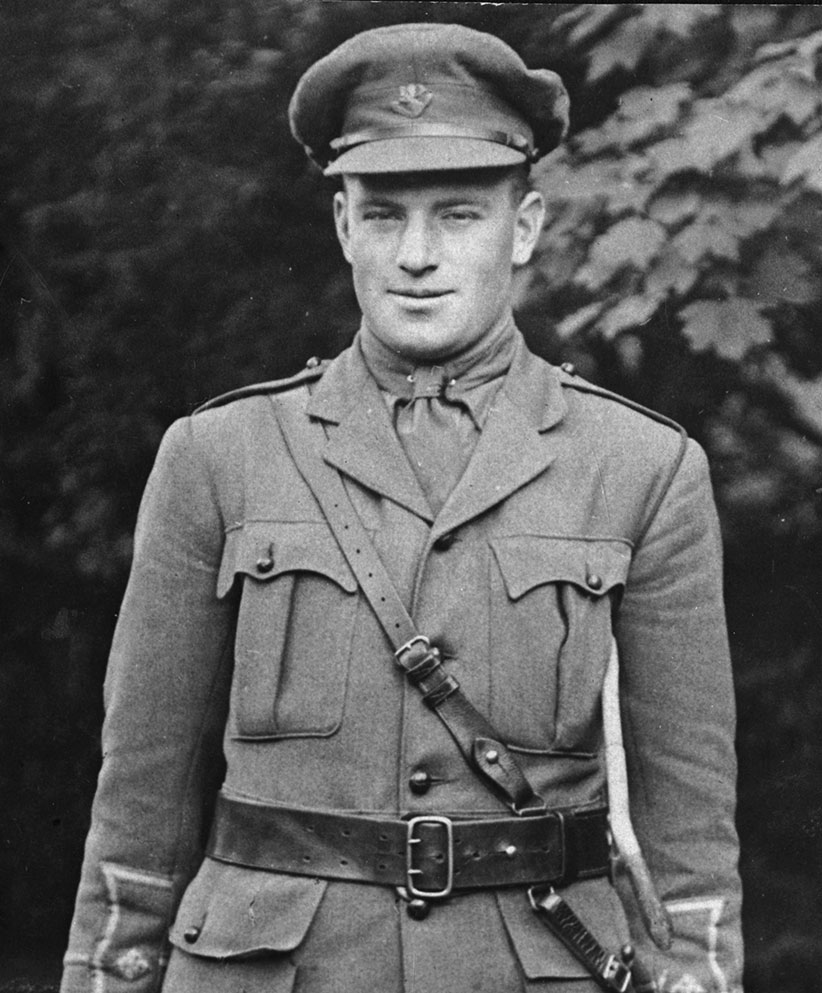Beaumont-Hamel is Newfoundland’s raw wound
On July 1, 1916, the Royal Newfoundland Regiment suffered a massive military tragedy—and changed Canada’s newest province
The loss of so many men is cited as a factor that led to Newfoundland joining Canada. (Room Archives)
Share
This article originally appeared in June, 2016, in the lead-up to the 100th anniversary of the Battle of Beaumont-Hamel
On July 6, 1916, a terse letter arrived at the Shortall home on Waterford Bridge Road in St. John’s. “Dear Madam,” it read. “I regret to inform you that the Record Office of the First Newfoundland Regiment, London, to-day reports that your son, Lieutenant Richard A. Shortall, was killed in action on 1st July. Sympathetically yours, Colonial Secretary.” They were not the only Newfoundland family to get such a note that day.
Until then, Newfoundlanders knew little of the tragedy that had befallen their regiment at Beaumont-Hamel on July 1, the opening day of the massive, brutal Somme offensive by Britain and its allies. On July 5, the Evening Telegram in St. John’s did report that some of Newfoundland’s soldiers had been wounded in France. It was, the paper said, “unmistakable evidence that our soldiers have seen heavy fighting.” Then, on July 6, came the names of eight officers killed in action, including Shortall. The day after that, there were six columns of the dead and wounded, and on subsequent days, there were more and more names. The Shortalls’ grief would soon be shared by families from Harbour Grace to St. George’s.
Beaumont-Hamel was a true Newfoundland calamity. In the first two hours of the attack, 85 per cent of the Newfoundland regiment’s soldiers and officers were casualties of a withering German barrage: 324 killed or missing, another 386 wounded. Many died before reaching the Danger Tree, a blasted rump of an apple tree midway to the German line. Only 68 men answered roll call the next morning. For a dominion of only 240,000, it was a grievously high price exacted in the lives of young men.

A few years ago, the province’s museum and archives, the Rooms, seeking guidance on how to expand its collection, asked the public “for the formative event in our history that most created our unique culture and sense of identity,” explains its CEO Dean Brinton. More than 90 per cent said Beaumont-Hamel.
Such was the cost that Beaumont-Hamel is more than a defeat, it’s become a defining symbol in Newfoundland and Labrador, absorbed into its cultural DNA, proof that the province is more than a time zone; it was once a dominion, a nation in its own right whose people fought and died in numbers that seem almost inconceivable today.
The regiment, which traced its lineage back to the 18th century, would recover from Beaumont-Hamel and fight with such ferocity that it would be the only unit bestowed the title “royal” by George V during the war. Yet it’s Beaumont-Hamel that is remembered as the seminal battle. “If your roots go back, chances are you lost someone,” says the Rooms’ Brinton.
Related: The Battle of Jutland was chaotic, bloody and a mass of ironies
Today, the vast majority of the surviving Great War battlefields in Europe belong to Canada, contained within two National Historic Sites: Beaumont-Hamel and Vimy Ridge. Each marks a turning point in a dominion’s history: the military victory at Vimy Ridge is seen as the moment when Canada became a country, while the loss at Beaumont-Hamel is remembered, at least in one part of the nation, as the day Newfoundland’s independence began to slip away.
On July 1 this year, tens of thousands will gather to honour their regiment at the National War Memorial in St. John’s on the 100th anniversary of the battle. Among the throngs will be Seamus O’Regan, Liberal MP for St. John’s South–Mount Pearl; on his lapel he’ll wear the island’s symbol of remembrance, a forget-me-not. O’Regan has a special tie to Beaumont-Hamel: his great-great-uncle is Richard Shortall.
Richard Aloysius Shortall, a 23-year-old electrician (hair: light brown, eyes: blue), enlisted in 1914, a month after war broke out, his regimental number, 395, made him one of the famous Blue Puttees, the first 500 who joined the Newfoundland Regiment. He was quickly promoted to lance corporal, then given an officer’s commission the following April. Wounded at Gallipoli in November, he was promoted to full lieutenant in the spring of 1916. Then came Beaumont-Hamel. Did Shortall die moments after climbing over the top of his own trench? Did he make it to the Danger Tree? No one knows. In the chaos of that day, and those that would follow, his body was never found. Shortall’s headstone, like so many in the Great War, carries a haunting phrase, “Buried near this spot.”

O’Regan only discovered his link to Beaumont-Hamel in the early 2000s, when his brother, Danny, a naval officer and the family historian, discovered an old framed scroll honouring Shortall while rummaging in their parents’ basement. On one margin was a handwritten note from governor Walter Davidson commending “this very gallant and highly efficient officer.” Though their mother knew her great-uncle died in the First World War, she’d never mentioned it to her children. “I think they were perhaps taken off guard by the amount of patriotism of the younger generation,” O’Regan explains. He wasn’t. For a decade, he was on the board of the Rooms and helped spearhead its 100th anniversary efforts. On July 1, the archives and museum will unveil an $11-million expansion, including a new gallery and exhibit devoted to the battle and the Royal Newfoundland Regiment.
July 1 is Memorial Day in the province. That it’s also Canada Day is lost on no one. “It’s the unfortunate cruel irony that Canada’s national holiday has to be on the anniversary of this terrible event in Newfoundland’s history,” says Angela Duffett, who grew up in Bonavista, Nfld. In 2006, she was a guide at Beaumont-Hamel, where the regiment marked the battle’s 90th anniversary. It was then, says Lieut.-Col. Kevin Bond, commander of the 2nd Battalion, that they decided to honour their predecessors in Newfoundland for the 100th anniversary. “It was a defining moment for Newfoundland, not a defining moment for the rest of the world,” Bond explains from Corner Brook, Nfld.
Related: The Easter Rising that changed everything for Ireland
After months drilling on parade grounds, some 150 reservists of the regiment’s battalions will come together in Corner Brook in late June for two days of rehearsals before a series of carefully choreographed events begin. Joining them on a four-day visit is their colonel-in-chief, Princess Anne. While the rest of the royal family—including Prince Charles and his wife, Camilla, at Beaumont-Hamel—will be at ceremonies marking the 100th anniversary of the start of the Somme offensive in Britain and France, she will be in Newfoundland presenting Bond’s battalion with new colours, including three honours from the War of 1812. While she’s in Corner Brook, she’ll also unveil a bronze sculpture of the iconic Danger Tree. Then, with the entire regiment, the Queen’s daughter will attend the July 1 remembrance ceremony in St. John’s.
Some Newfoundlanders, including 10 soldiers and an officer from the regiment, are making the trek to Beaumont-Hamel, which, along with the rest of the Somme front, is expected to be overwhelmed by heavy security and upwards of 60,000 people, including thousands of Canadians. There the group will take part in commemorative events. Martin Currie, the Catholic archbishop of St. John’s and Geoff Peddle, the Anglican bishop of eastern Newfoundland and Labrador, will jointly lay a wreath at the memorial. It’s a symbol of how the regiment broke down “the differences between Catholic and Protestant, rich and poor,” Currie explains. “It drew them together into this common cause, and changed the thinking of what it meant to be a Newfoundlander.” He and Peddle are leading a tour of some 150 Newfoundlanders on the Trail of the Caribou, the five battlefields in France and Belgium now marked with large bronze caribou, the regiment’s emblem, standing high on craggy stone outcroppings. Currie calls it a “pilgrimage,” since the locales are “sacred ground, hallowed by the deaths of those men.”
That Beaumont-Hamel as well as the other four sites exist is largely due to Father Thomas Nangle, the regiment’s wartime padre, explains Duffett, a Ph.D. history student at Queen’s University. After the war, Nangle was responsible for finding the dominion’s hastily buried soldiers and interring them in proper cemeteries. He saw what other nations were doing to honour their war dead, and “was adamant that Newfoundland not skimp on building its monuments,” says Duffett. He persuaded the dominion to buy the land at Beaumont-Hamel and place caribou at the sites of major regimental battles.
One of Nangle’s imposing bronze caribou looms over the countryside at Gueudecourt, France. There, on Oct. 11, 1916, Lieut. Stephen Norris was killed by artillery fire. “He was like so many Newfoundlanders of his age, he answered the call, definitely against the wishes of his family, both mother and father,” says his great-nephew John Wheeler. Norris’s father—kingpin of Three Arms, a village in Green Bay on the northeast coast—owned the fish-canning business, schooners and the general store. After Norris’s death, his parents were heartbroken. A haunting picture shows them in one of France’s still muddy battlefields, fruitlessly looking for his body. Soon, his father was dead, and with no one to take over his businesses, so was Three Arms. Today, the once-bustling community has been replaced by forest.

On May 12, Wheeler and his cousin Anne Lilly were in the House of Assembly to hear Stephen Norris’s name read into Hansard. Since March 10, the names of the fallen have been uttered aloud into a silent House during each sitting. It’s a way to honour all 1,600 men and women who died during the First World War while “serving under the banner of the Dominion of Newfoundland,” explains Speaker Tom Osborne. He’s talked with family members who have travelled from as far away as Labrador to hear their loved ones’ names spoken in the legislature.
“If you’re from Newfoundland, you think, ‘For Christ’s sake, will it ever end?’ From the cod moratorium, through the boom and bust of oil and gas, why do people have such pride in their place of birth?” the Rooms’ Brinton asks rhetorically. “Isolation, really terrible weather, economic hardship—why do people put up with this? A lot has to do with the fact that we have these symbols.”
For much of the Great War, Newfoundland was still called an “ancient and loyal colony,” says Duffett, who explored how the public’s ideas regarding the battle have changed over time in her master’s thesis, “Memory, Myth and Memorials: Newfoundland’s Public Memory of the First World War.” Only after the war, as the province designed the battlefield park and memorial, did the more independent term “dominion” come into common usage among Newfoundlanders, Duffett states. By then, Beaumont-Hamel was seen as a “nation-building, nation-defining story.” Later, after Confederation—when, after a bitterly fought referendum, Newfoundland joined Canada as the 10th province—the tragedy was “talked about as this catalyst that leads to the loss of nationhood,” Duffett discovered.
Related: In the Great War, 1916 marked the point of no return
Today, Beaumont-Hamel is widely perceived as the beginning of the end of Newfoundland’s nationhood, that the loss of so many good men, bestowed with the title “the best of Newfoundland,” sent the dominion down the road to economic and political ruin that led to it joining Canada. Those are very much post-Confederation beliefs, explains Duffett.
David Dean isn’t surprised that Newfoundland’s sense of its own identity and its relationship to Beaumont-Hamel has changed over time. “Passing on memories and stories to the next generation is very important,” explains the history professor, a co-director of the Carleton Centre for Public History in Ottawa. “It’s not that we lose the connection, it’s that we reinvent the connection.” Whether it’s the official story, or ones passed down by individuals and families, “both of those shift over time, and that becomes particularly acute when the generation that experienced the event being commemorated have passed away.”
The current surge of interest in Beaumont-Hamel, and its impact on Newfoundland, is part of a “memory boom” as people rush to record everything they can before the generations who endured the world wars die out, Dean explains. When experts from the Rooms toured the province asking for donations, they were overwhelmed: gifts included a war-era prosthetic leg, stacks of letters, even a life-saving New Testament, complete with bullet hole.
For the Rooms’ Brinton, his task is clear: “You have to take concrete steps to make sure this history doesn’t evaporate into the ozone, along with everything else.” So along with the new exhibit, the Rooms is creating school programs to keep the stories alive, helped by contributions. It isn’t all dry facts. In advance of the centenary, students took part in a First World War physical-training challenge, doing the same planks, stretches and jumps that got the Blue Puttees into fighting shape.
Four years ago, Brinton made a discovery of his own. Researching a newly discovered photo of his great-grandfather with his four children, he found that the eldest child, Saul Keefe, enlisted at 18, sending half his pay to his then-orphaned siblings in the family home in Twillingate, Nfld. In 1917, four days after being captured by the Germans at Monchy-le-Preux, he died of his wounds. Brinton had never heard about his father’s uncle. Until then, he’d known little of his family history. Now he discovered his grandmother had been “totally traumatized” by her brother’s death.
The fallout continued to the next generation as his father, in reaction to a gloomy home life, was “hell-bent on getting out” of Newfoundland and rejected “anything to do with Newfoundland culture.” Everything about his family made sense once Brinton discovered Keefe and what he did during the Great War. As he explains, “Thousands and thousands of families have a similar story. That’s why Beaumont-Hamel is so close to our hearts.”
Seamus O’Regan shares Brinton’s deep emotional connection to Beaumont-Hamel. “On every other score, I’m such a boastful Newfoundlander. I have waved the flag and shown my heart,” O’Regan explains. “Yet, this is ours. I want people to know this one means a lot. It’s to the bone.”
His great-great-uncle’s name was said aloud in the House of Assembly on May 30. On June 9, the last 41 names of the dominion’s war dead echoed in the chamber. Among them were a father and son, Andrew Wilson Sr. and Jr., members of the Newfoundland Mercantile Marine who died on Jan. 21, 1918, when their ship was sunk on its way to Gibraltar. Like so many, their names are inscribed on the memorial at Beaumont-Hamel, under the watchful eyes of the bronze caribou, perched on its crag.